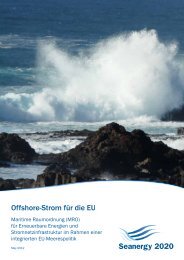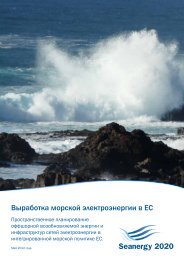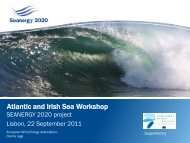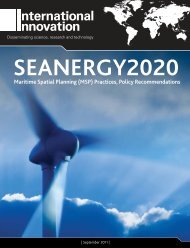Comparative analysis of Maritime Spatial Planning ... - Seanergy 2020
Comparative analysis of Maritime Spatial Planning ... - Seanergy 2020
Comparative analysis of Maritime Spatial Planning ... - Seanergy 2020
Create successful ePaper yourself
Turn your PDF publications into a flip-book with our unique Google optimized e-Paper software.
Table 3: Overview state <strong>of</strong> play in MSP processes and NREAP <strong>2020</strong> <strong>of</strong>fshore targets in the North SeaNorth Sea MSP process Installed NREAP <strong>2020</strong> EEZStates<strong>of</strong>fshore wind(MW)<strong>of</strong>fshore target(MW)Belgium 1 ORE area 195 2,000 55 wind YesDenmark ORE zoning 56 386 57 1,339 58 wind YesGermanyMSP in EEZ 90 59 10,000 60 wind Yes(2009)Netherlands 2 OWE areas 228 5,178 wind YesUKCriteria based 1,341 12,990 wind YesMSPand1,300wave and tidalMSP policies and legal frameworks in the North Sea basin have progressed well over the last decade,as well as licensing processes, stakeholder consultation, sector conflict management, data andinformation management, cross border and regional cooperation and implementation <strong>of</strong> MSP. Withinthe North Sea basin different MSP models coexist but they appear to generate more or less the sameoutcome in terms <strong>of</strong> installed and projected <strong>of</strong>fshore energy capacity 61 .Countries like Germany and the Netherlands have recently finalised a comprehensive MSP legalframework policy in which reserved maritime zones are delimitated. Denmark and Belgium haveconducted an MSP-like exercise resulting in the delimitation <strong>of</strong> ORE zones. The difference withGermany and the Netherlands is that the ORE zoning legislation is based on energy laws rather thanon MSP legislation. The UK has a completely different policy: it works with a zoning approach that isnot defined by the state but based on criteria, which leaves more freedom to the developers and, intheory, more spatial possibilities for ORE development.It is difficult to state whether one approach is more efficient than the other; all the above modelshave so far attracted ORE developers. This indicates that all the (maritime) spatial planningapproaches have their benefits in term <strong>of</strong> legal certainty. What is likely to stop or slow down the55 The Belgian NREAP does not provide an on- and <strong>of</strong>f-shore split for the overall wind energy capacity figure.However, information subsequently obtained by EWEA indicates that the <strong>2020</strong> target for <strong>of</strong>fshore windcapacity is 2,000 MW,56 In progress, remains to be agreed,57 Just for the North Sea,58 Including the Baltic Sea,59 Just for the North Sea60 Including the Baltic Sea,61 In proportion to the respective available maritime spaces <strong>of</strong> every North Sea country.Deliverable D 2.385 | P a g e






